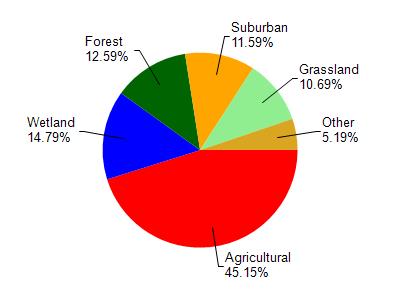Racine
No
No
No
Fish and Aquatic Life
Overview
Managed for largemouth bass and panfish. Weeds are a major use problem since about 10 percent of the lake is covered by less than three feet of water. Public access is provided at a county park which has a blacktop and gravel launching area and ample parking. The park also affords supervised swimming and picnicking facilities. There are nine resorts on this lake and four boat rental facilities. The lake shore is approximately 90 percent developed for home sites; in addition, several channels off the northeast shore provide water frontage. A 10 foot wide concrete impounding structure maintains a two foot head on the outlet which flows to Hoosier Creek. There are 18 acres of marshy wetland on or near this lake. Two natural islands lie within the lake basin.
Source: 1961, Surface Water Resources of Racine County Browns Lake, Surface Acres = 383, S.D.F. = 1.82, Maximum Depth = 44 feet, (T-3-N, R-19-E, Sec. 27, 28, 33, 34).
Date 1961
Author Aquatic Biologist
General Condition
Browns Lake (750300) was assessed during the 2016 listing cycle; total phosphorus sample data were clearly below 2016 WisCALM listing thresholds for Recreation use and Fish and Aquatic Life use. Chlorophyll sample data were clearly below FAL use listing thresholds and did not exceed REC listing thresholds. This water is meeting these designated uses and is not considered impaired.
Date 2015
Author Ashley Beranek
Condition
Wisconsin has over 84,000 miles of streams, 15,000 lakes and milllions of acres of wetlands. Assessing the condition of this vast amount of water is challenging. The state's water monitoring program uses a media-based, cross-program approach to analyze water condition. An updated monitoring strategy (2015-2020) is now available. Compliance with Clean Water Act fishable, swimmable standards are located in the Executive Summary of Water Condition in 2018. See also the 'monitoring and projects' tab.
Reports
Management Goals
Wisconsin's Water Quality Standards provide qualitative and quantitative goals for waters that are protective of Fishable, Swimmable conditions [Learn more]. Waters that do not meet water quality standards are considered impaired and restoration actions are planned and carried out until the water is once again fishable and swimmable
Management goals can include creation or implementation of a Total Maximum Daily Load analysis, a Nine Key Element Plan, or other restoration work, education and outreach and more. If specific recommendations exist for this water, they will be displayed below online.
Monitoring
Monitoring the condition of a river, stream, or lake includes gathering physical, chemical, biological, and habitat data. Comprehensive studies often gather all these parameters in great detail, while lighter assessment events will involve sampling physical, chemical and biological data such as macroinvertebrates. Aquatic macroinvertebrates and fish communities integrate watershed or catchment condition, providing great insight into overall ecosystem health. Chemical and habitat parameters tell researchers more about human induced problems including contaminated runoff, point source dischargers, or habitat issues that foster or limit the potential of aquatic communities to thrive in a given area. Wisconsin's Water Monitoring Strategy was recenty updated.
Grants and Management Projects
Monitoring Projects
| WBIC | Official Waterbody Name | Station ID | Station Name | Earliest Fieldwork Date | Latest Fieldwork Date | View Station | View Data |
|---|
| 750300 | Browns Lake | 524001 | Browns Lake - Browns Lake | 9/5/1979 | 9/17/2019 | Map | Data |
| 750300 | Browns Lake | 523120 | Browns Lake - Deep Hole | 9/19/1973 | 9/15/2025 | Map | Data |
| 750300 | Browns Lake | 10007841 | Browns Lake | 6/1/1988 | 9/21/2018 | Map | Data |
| 750300 | Browns Lake | 10017998 | Browns Lake -- Access Nr Durand Ave | 6/29/2003 | 8/13/2025 | Map | Data |
| 750300 | Browns Lake | 523094 | Wind Lake Canal at Sth 20 | | | Map | Data |
|

Watershed Characteristics
Browns Lake is located in the Lower Fox River - Illinois watershed which is 114.04 mi². Land use in the watershed is primarily agricultural (45.20%), wetland (14.80%) and a mix of forest (12.60%) and other uses (27.50%). This watershed has 144.75 stream miles, 2,176.46 lake acres and 9,772.38 wetland acres.
Nonpoint Source Characteristics
This watershed is ranked Medium for runoff impacts on streams, Medium for runoff impacts on lakes and High for runoff impacts on groundwater and therefore has an overall rank of High. This value can be used in ranking the watershed or individual waterbodies for grant funding under state and county programs.This water is ranked High Lake for individual Lakes based on runoff problems and the likelihood of success from project implementation.